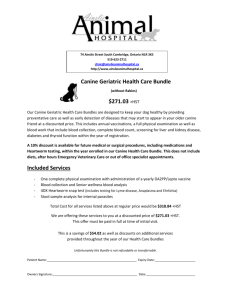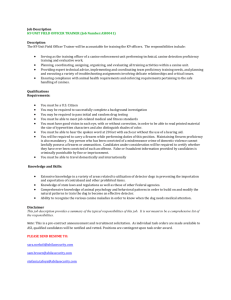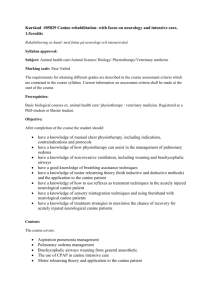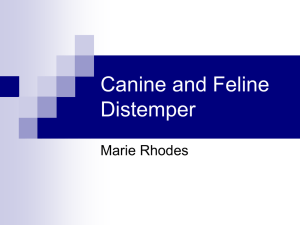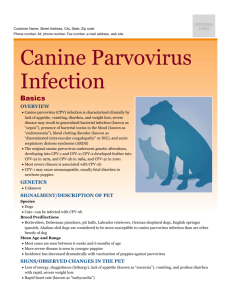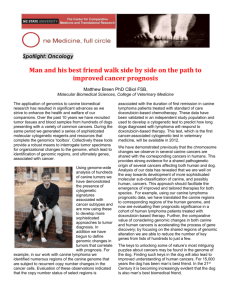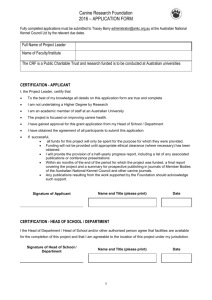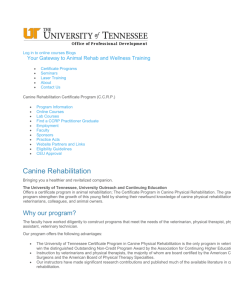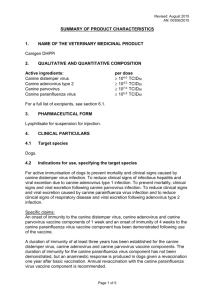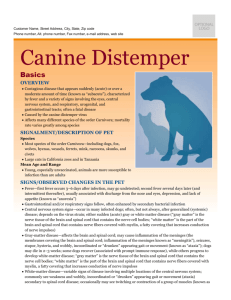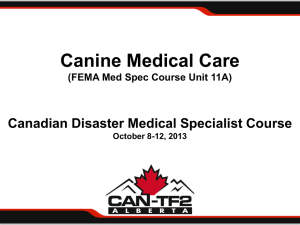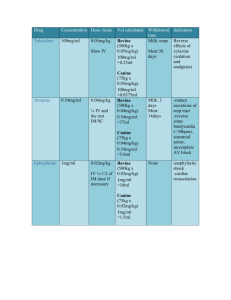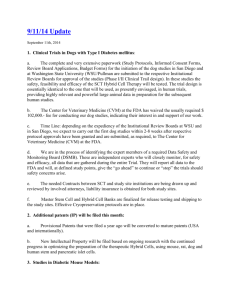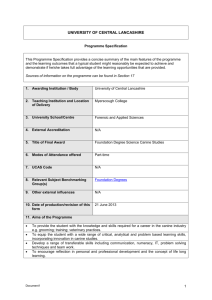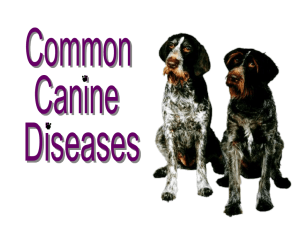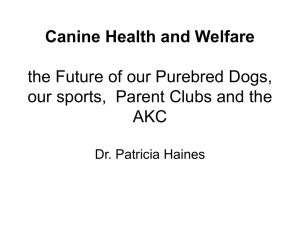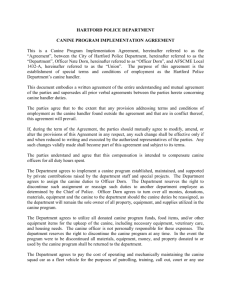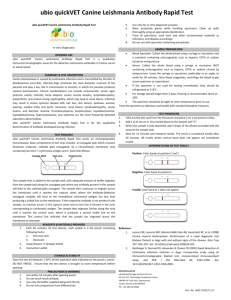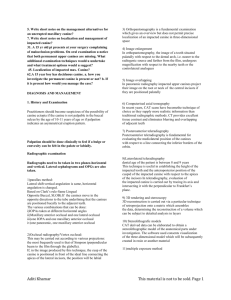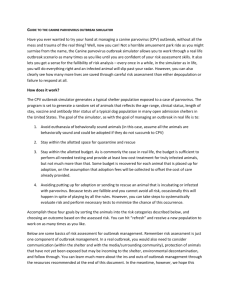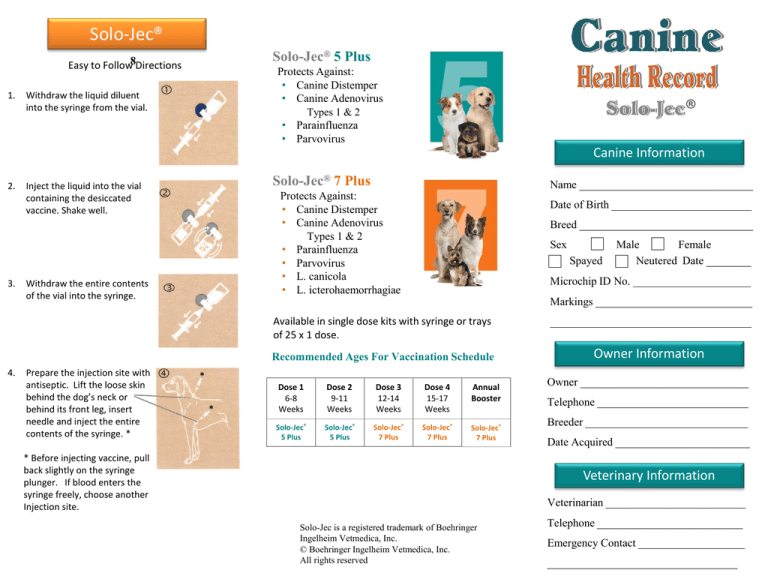
Solo-Jec®
Solo-Jec® 5 Plus
Easy to Follow8Directions
1.
Protects Against:
• Canine Distemper
• Canine Adenovirus
Types 1 & 2
• Parainfluenza
• Parvovirus
Withdraw the liquid diluent
into the syringe from the vial.
®
Canine Information
2.
3.
4.
Solo-Jec® 7 Plus
Inject the liquid into the vial
containing the desiccated
vaccine. Shake well.
Withdraw the entire contents
of the vial into the syringe.
Prepare the injection site with
antiseptic. Lift the loose skin
behind the dog’s neck or
behind its front leg, insert
needle and inject the entire
contents of the syringe. *
Name _______________________________
Protects Against:
• Canine Distemper
• Canine Adenovirus
Types 1 & 2
• Parainfluenza
• Parvovirus
• L. canicola
• L. icterohaemorrhagiae
Date of Birth _________________________
Breed _______________________________
Sex
Spayed
Male
Female
Neutered Date ________
Microchip ID No. _____________________
Markings ____________________________
Available in single dose kits with syringe or trays
of 25 x 1 dose.
____________________________________
Recommended Ages For Vaccination Schedule
Owner Information
*
*
Dose 1
6-8
Weeks
Dose 2
9-11
Weeks
Dose 3
12-14
Weeks
Dose 4
15-17
Weeks
Annual
Booster
Solo-Jec®
5 Plus
Solo-Jec®
5 Plus
Solo-Jec®
7 Plus
Solo-Jec®
7 Plus
Solo-Jec®
7 Plus
* Before injecting vaccine, pull
back slightly on the syringe
plunger. If blood enters the
syringe freely, choose another
Injection site.
Owner ______________________________
Telephone ___________________________
Breeder _____________________________
Date Acquired ________________________
Veterinary Information
Veterinarian _________________________
Solo-Jec is a registered trademark of Boehringer
Ingelheim Vetmedica, Inc.
© Boehringer Ingelheim Vetmedica, Inc.
All rights reserved
Telephone __________________________
Emergency Contact ___________________
__________________________________
Vaccination Record
Vaccinate For These Canine Diseases
Canine Distemper
Transmitted by direct or indirect contact with the discharge
from an infected dog’s eyes, nose or urine. Widespread,
highly contagious and usually deadly, even among older
dogs. A primary killer of puppies
Age
Canine Adenovirus Type 1 & 2
___ weeks _____
Hepatitis is caused by Adenovirus type-1 and attacks the
liver. Transmitted through contact with objects contaminated
by urine, saliva and feces. Early signs are similar to distemper.
Adenovirus type-2 is a respiratory infection that may be
associated with kennel cough.
Canine Parainfluenza
Mild respiratory tract infection transmitted through contact
with nasal secretions. Infection is more severe in young
puppies.
Date
___ weeks _____
___ weeks _____
___ weeks _____
___ weeks _____
Medical Record
Date
________
________
________
________
________
________
________
________
________
________
Results / Treatment
__________________________
__________________________
__________________________
__________________________
__________________________
__________________________
__________________________
__________________________
__________________________
__________________________
1 year
_____
Canine Parvovirus
2 years
_____
Highly resistant virus withstands extreme temperature changes
and exposure to most disinfectants. May cause severe diarrhea
and vomiting. A highly contagious disease and especially
dangerous for puppies.
3 years
_____
4 years
_____
Canine Coronavirus
5 years
_____
A highly contagious, but mild and self-limiting intestinal
disease. Causes vomiting and diarrhea in dogs of all ages,
but is seen most often in young puppies.
6 years
_____
7 years
_____
8 years
_____
9 years
_____
10 years
_____
11 years
_____
12 years
_____
Fecal / DeWorming
13 years
_____
Date
________ _________________________________
14 years
_____
_______
_______
_______
_______
_______
_______
_______
_______
_______
Canine Leptospirosis
Lepto is an infectious bacterial disease transmitted by contact
with infected urine from rodents and other animals. Can be
spread to humans as well as other animals and may cause
permanent kidney damage.
Canine Bordetella Bronchiseptica (Kennel Cough)
A bacterial respiratory tract infection transmitted by nasal
and oral secretions. Harsh, non-productive cough may last
1-3 weeks. Bordetella infections can occur alone or in combination with other respiratory problems.
Canine Borreliosis (Lyme Disease)
Bacterial infection spread by a bite from an infected tick.
Symptoms include fever, lethargy and muscle stiffness.
Lameness can occur in more severe cases.
Rabies
The most feared disease and is almost always fatal. Attacks
the brain and central nervous system. Transmitted to humans
through a bite or scratch by an infected animal.
Veterinary / Breeder Comments
_______________________________________________
_______________________________________________
_______________________________________________
_______________________________________________
Heartworms
Year
Pos. Neg Treatment/Prevention
_______
___________________
_______
___________________
_______
___________________
_______
___________________
_______
___________________
_______
___________________
_______
___________________
_______
___________________
_______
___________________
_______
___________________
_____________________________
_____________________________
____________________________
_____________________________
_____________________________
____________________________
_____________________________
_____________________________
_____________________________

